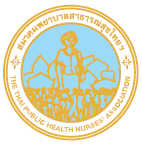Lived Experience of Patients with Spinal Muscular Atrophy
Keywords:
Lived Experience, Patient, Spinal Muscular AtrophyAbstract
The qualitative phenomenological research has the objectives to narrate and describe lived experience of patients with spinal muscular atrophy. Ten informants were purposively selected from among patients who had been diagnosed with spinal muscular atrophy and had been suffering from the illness for more than 10 years. Data were collected using in-depth interviews with an interview guide which was analyzed and interpreted applying the Husserl framework and 7 steps of Colaizzi’s method of data analysis. The findings indicated that the informants defined the lived experience through 4 (theme) transitional phrases: 1) loss of control; 2) adjustment to limitations; 3) transcending limitations; and 4) living with hope. The results of this study provided in-depth understanding of experiences faced by the patients of spinal muscular atrophy in terms of disease trajectories, living life and coping with transitional phrases of disease. The data was useful in order that the healthcare workers and relevant organizations could provide support and necessary infrastructures; arrange appropriate environment; provide treatment; and prevent complications appropriately with consideration on flexibility of living along with the patient’s suffer and overcoming the limit of oneself.
References
Boonsue P, Kittiponghansa S, Siripaopradit T, Jitpimolmard S. Familial Spinal Muscular Atrophy with Additional Features: A family report. Srinagarind Med J 1995; 10(1): 13-25.
Sproule DM, Kaufmann P. Therapeutic developments in spinal muscular atrophy. Ther Adv Neurol Disord 2010; 3(3): 173–85.
Rutkove SB, Shefner JM, Gregas M, Butler H, Caracciolo J, Lin C, Fogerson PM, Mongiovi P, Darras BT. Characterizing spinal muscular atrophy with electrical impedance myography. Muscle & Nerve 2010; 42(6): 915-21.
Ho H-M, Tseng Y-H, Hsin Y-M, Chou F- H, Lin W-T. Living with illness and self-transcendence: the lived experience of patients with spinal muscular atrophy. JAN 2016; 72(11): 2695–705.
Chaisomchit S, Thongnoppakhun W, Pho-iam T, Limwongse C, Likasitwattanakul S, Chareonsiriwatana W, et al. Investigation of carrier frequency for spinal muscular atrophy in Thailand using dried blood spot specimens. G&G 2016; 9(2&3): 78–84.
Yang B-H, Chung C-Y, Weng W-C, Lo K-w, et al. Self-care Experiences of Adolescents with Spinal Muscular Atrophy, Asian Nurs Res 2021; 15: 231-38.
Speziale HJS, Carpenter DR. Qualitative research in nursing: Advancing the humanistic imperative. (4th ed.). Philadelphia: Lippincott; 2007.
Husserl E. Phenomenology and the Crisis of Philosophy (Lauer Q. trans.). New York: Harper & Row; 1965.
Polit DF, Beck CT. Nursing research: generating and assessing evidence for nursing practice. (8th ed.). Philadelphia, PA: Lippincott Williams & Wilkins. 2008.
Colaizzi PF. Psychological research as the phenomenologist views it. In Ronald S. Valle & Mark King (eds.), Existential-Phenomenological Alternatives for Psychology. Oxford University Press, 1978.
McClelland SB. Training needs assessment data-gathering methods: Part 2 – individual interviews. J Eur Ind Train 1994; 18(2): 27–31.
Hsieh HF, Shannon SE. Three approaches to qualitative content analysis. Qual Health Res 2005; 15(9): 1277-88.
Creswell JW. Research design: Qualitative, quantitative and mixed methods approaches. (2nd ed.). London: Sage Publications; 2003.
Wei CH. The lived meaning of self-transcendence-service learning as an example. Journal of Holistic Education 2007; 1: 139–54.
Coward DD. Self- transcendenceand correlates in a healthy population. Nurs Res 1996; 45(2): 116–21.
Frankl VE. Man’s Search for Ultimate Meaning. New York: Perseus Publishing; 2000.
Lamb C, Peden A. Understanding the experience of living with spinal muscular atrophy: a qualitative description. J Neurosci Nurs 2008; 40(4): 250–6.
Tseng CN, Chan HY, Dai YT. Dignity: a concept analysis. VGH Nursing 2001; 28(1): 97–103.
Downloads
Published
How to Cite
Issue
Section
License
Copyright (c) 2022 Thai Public Health Nurses Association

This work is licensed under a Creative Commons Attribution-NonCommercial-NoDerivatives 4.0 International License.
บทความที่ตีพิมพ์และแผนภูมิรูปภาพถือเป็นลิขสิทธิ์ของวารสารพยาบาลสาธารณสุข (Thai Public Health Nurses Association)







